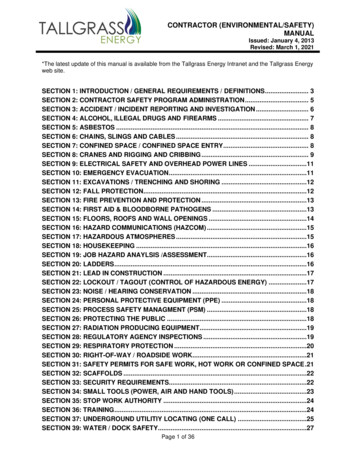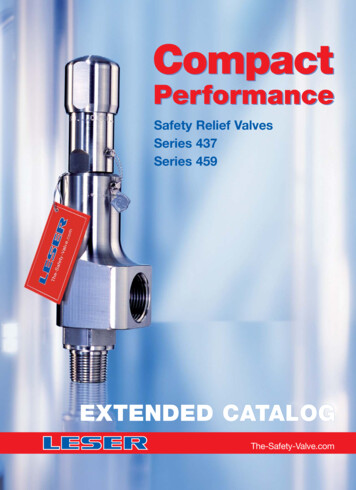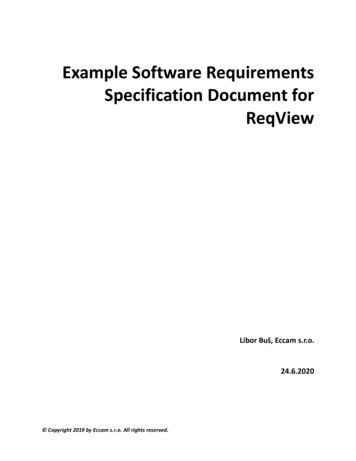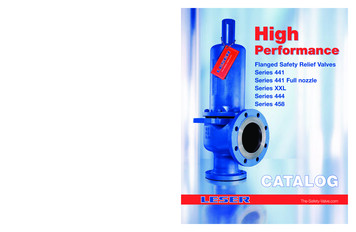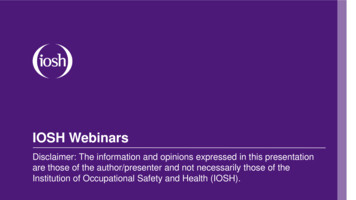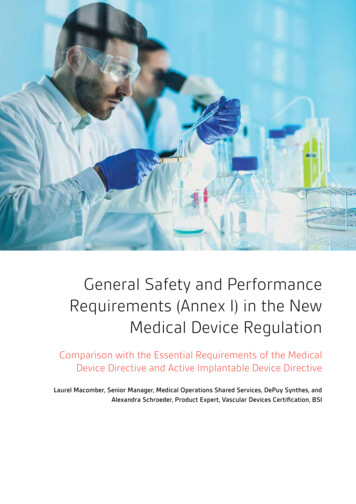
Transcription
General Safety and Performance Requirements (Annex I) in the NewMedical Device RegulationComparison with the Essential Requirements of the Medical Device Directive and Active Implantable Device DirectiveLaurel Macomber, Senior Manager, Medical Operations Shared Services, DePuy Synthes, andAlexandra Schroeder, Product Expert, Vascular Devices Certification, BSI
General Safety and Performance Requirements (Annex I) in the New Medical Device RegulationContentsIntroduction 1SPR 1: Performance and safety 2SPR 2: Reduction of risks 2SPR 3: Risk management system 2SPR 4: Risk control measures and residual risks 2SPR 5: Risks related to use 3SPR 6: Device lifetime 3SPR 7: Packaging, transport, storage 3SPR 8: Risk-benefit ratio 3SPR 9: Devices without a medical purpose 4SPR 10: Chemical, physical and biological properties 4SPR 10.1: General considerations for materials 4SPR 10.2: Risks from contaminants and residues 5SPR 10.3: Compatibility with materials and substances 5SPR 10.4: Substances contained in and released from the device 5SPR 10.5: Risk of unintentional ingress 6SPR 10.6: Risks related to particle size 6SPR 11: Infection and microbial contamination 6SPR 11.1: Risk of infection 6SPR 11.2: Design for reuse 7SPR 11.3: Devices with a specific microbial state 7SPR 11.4: Devices delivered sterile 7SPR 11.5: Validation for sterile devices 7SPR 11.6: Environmental controls 7SPR 11.7: Packaging for non-sterile devices 8SPR 11.8: Labelling for sterile state 8SPR 12: Devices incorporating a medicinal product; substances absorbed or locally dispersed 8SPR 12.1: Devices incorporating a medicinal product 8SPR 12.2: Devices composed of substances absorbed or locally dispersed 8SPR 13: Devices incorporating materials of biological origin 9SPR 13.1: Tissues, cells or derivatives of human origin 9SPR 13.2: Tissues, cells or derivatives of animal origin 9SPR 13.3: Other non-viable biological substances 9SPR 14: Construction of devices and interaction with their environment ii9
bsigroup.comSPR 14.1: Use in combination 10SPR 14.2: Risks of interaction with the environment 10SPR 14.3: Risks of fire or explosion 10SPR 14.4: Design for adjustment, calibration and maintenance 10SPR 14.5: Design for compatibility 11SPR 14.6: Measurement, monitoring or display scales 11SPR 14.7: Design and manufacture for safe disposal 11SPR 15: Devices with a diagnostic or measuring function 11SPR 16: Protection against radiation 11SPR 17: Electronic programmable systems and software 12SPR 18: Active devices and devices connected to them 12SPR 19: Particular requirements for active implantable devices 13SPR 19.1: Particular risks to be reduced for active implantable devices 13SPR 19.2: Device compatibility and reliability of energy 13SPR 19.3: Identification of devices and components 13SPR 19.4: Identification code 13SPR 20: Protection against mechanical and thermal risks 14SPR 21: Protection against the risks posed to the patient or user by devices supplyingenergy or substances 14SPR 22: Protection against the risks posed by medical devices intended by the manufacturerfor use by lay persons 14SPR 23: Label and instructions for use 14SPR 23.1: General requirements for information supplied by the manufacturer 15SPR 23.2: Label requirements 16SPR 23.3: Sterile package label requirements 17SPR 23.4: Instructions for Use 18Absent in SPR list: Clinical evaluation, medicinal consultation 20Demonstrating and documenting compliance 20Conclusions 21Appendix 1: Medical Devices Regulation (MDR) 22Safety and Performance White paper author and reviewer biographical 27About BSI Group 29iii
bsigroup.comIntroductionAs compliance with the ‘Essential Requirements (ERs)’ is the keystone for establishing conformity with the MedicalDevice Directive (MDD, 93/42/EEC) and Active Implantable Medical Device Directive (AIMDD, 90/385/EEC), so toois compliance with the ‘General Safety and Performance Requirements (SPRs)’ in establishing conformity with therecently published Medical Device Regulation – EU Regulation 2017/745 (MDR). The Regulation’s date of publicationwas 5 May 2017 and date for Entry into Force was 25 May 2017 with a 3-year transition period. The purpose of thiswhite paper is to compare the ERs in the MDD and AIMDD to the SPRs in Annex I of the new MDR. Where there are13 ERs in the MDD and 16 in the AIMDD, there are 23 SPRs in the new MDR. The overall text and requirements areexpanded, but the scope and topics are consistent overall with the previous directives with a few notable exceptions.Some topics such as clinical evaluation and medicinal consultation have moved from the requirements list intothe articles, while other topics are new to the requirements list, including devices without a medical purpose andrequirements for devices used by lay persons. A number of areas now have increased emphasis and more explicitrequirements, which in many cases align with harmonized standards and industry guidances. Importantly, all of thesepoints will now become European law under this Regulation. The areas in Annex I considered to have highest impactto manufacturers are: medicinal substances (and substances absorbed or locally dispersed);devices incorporating materials of biological origin;substances of concern;labelling requirements;emphasis on cybersecurity.What is the plan for implementation of the MDR?Entry into force, 25 May 2017Year -1Year 1Year 2Year 3Date of application 26 May 2020Year 4Year 5Year 6Year 7Year 8Certificates issued under MDD and AIMD before MDR publication havefull five year validityBatch verification certificates issued before MDR publication are validuntil two years after applicationCertificates to the MDD or AIMD issued after MDR publication have full five year validity,unless that exceeds four years after the date of applicationCertificates to the MDR can be issued from a designated Notified Body after MDR entry into force,and have certificate validity of five yearsNote: the blocks display the time period within which a certificate type can be valid, not the period of validity for a single certificateOther key areas of impact in the MDR outside Annex I include: clinical data and evaluation requirements;reclassification of some device types;post-market requirements.These topics outside Annex I are beyond the scope of the current white paper, but manufacturers should be awarethat these important areas are also changing in comparison to the directives. An updated white paper will followfocusing on the implications of the MDR and MEDDEV 2.7.1 Rev. 4 for clinical data and evaluation.1
General Safety and Performance Requirements (Annex I) in the New Medical Device RegulationThe paper is organized in order of the new safety and performance requirements by number, with the goal that thereaders begin to become familiar with the new numbering and organization. The intent is not to reproduce eachrequirement, but to highlight areas of particular similarity and difference between the ERs and SPRs. While manyof the SPRs (namely numbers 10-23) have explicit headings or titles, others have been added here in an attempt tohighlight the theme of each requirement.Cross-references to ERs and other documents with similar text have been identified for each requirement. In addition,each SPR has been graded (low, medium or high) relative to the expected impact of the changes to the manufacturer(see Appendix 1 for SPR/ER Cross-reference Mapping Guide).Understanding the SPRs will be an important aspect of manufacturers’ transition plans from the directives to the MDR.SPR 1: Performance and safetySPR 1 generally corresponds to AIMDD and MDD ER 1. In fact, much of the text is the same. This requirement statesthat the devices shall be ‘designed and manufactured in such a way’ that safety of patients and users shall not becompromised. As with ER 1 in the directives, this is under the normal conditions of use. The concept of ‘performance’is brought in from AIMDD ER 2 and MDD ER 3 to this requirement. The design and construction should conform tosafety principles, taking into account the ‘generally acknowledged state of the art’ as required in to MDD ER 2 andAIMDD ER 6. The risks related to ergonomic features and consideration of the use environment, present in MDD ER 1,have been moved to SPR 5.SPR 2: Reduction of risksSPRs 2-5 all relate to risk management. SPR 2 is a new, short and specific statement addressing the requirement toreduce risks as far as possible. It is clarified that this means reduction of risks as far as possible, without adverselyaffecting the risk-benefit ratio. This requirement is new versus the Directives, but is considered a clarification ofthe intent of the existing requirements in MDD ER 2 and AIMDD ER 8. In some cases, risks could be further reducedby changes in design, but important benefits and/or device performance may also be compromised by thesechanges, thus impacting the risk-benefit ratio. The risk reduction activities should not eliminate important devicebenefits without consideration of the risk-benefit ratio. The requirement to reduce risks as far as possible remaina discrepancy with the current risk management standard EN ISO 14971:2012, as addressed in Annexes ZA and ZBwith respect to the Directives. This requirement continues to be to reduce risks as far as possible without regard foreconomic consideration.SPR 3: Risk management systemSPR 3 is a new requirement without a general equivalent in the MDD and AIMDD. The basics of the risk managementprocess are more explicitly defined in SPR 3, in alignment with EN ISO 14971:2012. While this is already anexpectation of the harmonized standard which most manufacturers follow, this is now explicitly covered in theRegulation. It is noted that these points will now all be directly required as part of the risk management system,including evaluating of risks from foreseeable misuse.SPR 4: Risk control measures and residual risksSPR 4 generally corresponds to ER 2 in the existing MDD, and to a lesser extent, ER 6 in the AIMDD.A new, more explicit requirement coming in from EN ISO 14971:2012 Annex ZA Point 4(c) is the requirement that boththe overall residual risks and the residual risk associated with each hazard is evaluated and judged to be acceptable,with respect to the benefits. While this is already an expectation of the harmonized standard, this will now beexplicitly included in the Regulation.2
bsigroup.comIn addition, SPR 4 now more explicitly requires that warnings, precautions and contraindications be provided tousers, in the context of residual risks. Whereas the MDD required users to be informed of the ‘residual risks due to anyshortcomings of the protection measures adopted,’ the MDR says more broadly that the manufacturer ‘shall inform usersof any residual risks.’ This SPR might be interpreted to mean that all residual risks including possible adverse events andside effects identified by the manufacturer in the risk management process should be disclosed in the information forusers. This is further confirmed in SPR 23.4 with respect to the instructions for use (IFU) (discussed below).SPR 5: Risks related to useSPR 5 addresses reduction of risks relating to use error. This requirement generally corresponds to the latter part ofER 1 in the MDD. As already required by the MDD, the risk of use error shall be reduced as far as possible includingergonomic considerations and the knowledge, experience and types of users (e.g. clinicians, patients or caregivers).This is commonly known as usability or human factors. See BSI’s earlier white paper–‘The growing role of human factorsand usability engineering in medical devices’, which can be found here: -device-services/BSI-Medical-Devices-Whitepapers/. While there is no clear AIMDD counterpart to this SPR,AIMDD manufacturers are likely already considering risks relating to use in the implantation process per harmonizedstandards. These requirements are now explicitly included in the MDR.SPR 6: Device lifetimeSPR 6 defines requirements for the characteristics and device performance over the lifetime of the device as indicated.The ‘device lifetime’ requirement generally corresponds to ER 4 in the MDD and ER 3 in the AIMDD. Like the similarrequirements in the Directives, SPR 6 requires that the device characteristics and performance shall not be adverselyimpacted to such a degree that health or safety of a patient or user would be compromised, when under the stressesof ‘normal conditions of use.’ The lifetime is defined here as the lifetime ‘as indicated by the manufacturer,’ which alignswith the MDD ER 4, and is a change from AIMDD ER 3 which referred to the lifetime ‘anticipated by the manufacturer.’Supplementing similar requirements of both Directives, this SPR now states that device performance must notbe adversely impacted when the device ‘has been properly maintained in accordance with the manufacturer’sinstructions.’ Reasonably foreseeable maintenance or storage errors may be considered as part of use risk evaluation,but in some cases impacts to performance cannot be prevented when maintenance and storage are not per themanufacturer’s instructions.SPR 7: Packaging, transport, storageBasic requirements for device packaging, transportation and storage are outlined in SPR 7. This requirement canbe mapped to ER 5 in the MDD and ER 4 in the AIMDD. The intent of the requirement remains the same: that thedevice design, manufacturing and packaging will protect a device’s characteristics and performance for intended useduring transportation and storage, taking into account the [storage] instructions provided by the manufacturer. Therequirement specifically gives the example of potential temperature and humidity fluctuations (as in AIMDD ER 4),which are already typically considered by manufacturers in transportation simulations and storage restrictions ondevice labelling if necessary.SPR 8: Risk-benefit ratioThe MDR includes an updated definition of the ‘risk-benefit ratio’ to be assessed by the manufacturer in SPR 8. This riskbenefit evaluation per MDD ER 6 and AIMDD ER 5 corresponds to new SPR 8. It now includes ‘all known and foreseeablerisks,’ and that the risks ‘shall be minimized.’ The risks are explicitly weighed against the ‘evaluated benefits to the patientand/or user arising from the achieved performance,’ rather than the ‘performances intended.’ Lastly, the risk-benefitevaluation is clarified to be ‘during normal conditions of use.’ This might be interpreted as per the intended use andreasonably expected conditions of use. The intent of the risk-benefit evaluation remains the same, and the requirementitself is not new compared to the two Directives.3
General Safety and Performance Requirements (Annex I) in the New Medical Device RegulationSPR 9: Devices without a medical purposeDevices without a medical purpose are excluded from the scope of the MDD and AIMDD, but are included inthe MDR. SPR 9 clarifies how to apply the ‘risk-benefit’ and ‘performance’ requirements (SPRs 1 and 8) for thosedevices without a medical purpose or medical benefit. It is stated that the devices ‘shall not present any risk’ or‘no more than the maximum acceptable risks’ consistent with a high level of protection for safety and health.Devices without a medical purpose also have specific labelling/IFU requirements (see SPR 23.4 (x)). Annex XVI ofthe Regulation is devoted to a listing of these devices, and per Article 1.2 of the Regulation, Common Specifications(CS) are planned to be adopted to address these devices with respect to risk management and clinical evaluation ofsafety. It is anticipated that the CS specific to various device types (as provided for in MDR Recital 23 and 24) willadd clarity to the expectations for the ‘maximum acceptable risks’ and acceptably high levels of safety. However, inthe absence of CS, manufacturers must justify what the ‘maximum acceptable risks’ are. Such justifications wouldlikely include reference to industry guidances or standards for those devices or for similar devices with a medicalpurpose, to establish a comparison to the accepted state of the art. Although SPR 9 is specific to the devices withno medical purpose, interpretation of the Regulation expects that these devices will comply with all of the safetyand performance requirements in Annex I, with only the special allowances here for SPRs 1 and SPR 8.Common specificationsThe Medical Devices Regulation has provided for ‘CS’ in Article 9. These are defined in Article 2 as a set oftechnical and/or clinical requirements other than standard that provide a means of complying with the legalobligations applicable to a device, process or system.Article 9 states that CS will be adopted where no harmonized standards exist–OR–where relevant harmonizedstandards are not sufficient–OR–where there is a need to address public health concerns. These CS will bedeveloped by expert panels appointed by the Commission, in consultation with the Medical Device CoordinationGroup (MDCG, Article 103)Devices in conformity with CS shall be presumed to be in conformity with the relevant requirements of theMDR. The MDR states that manufacturers shall comply with applicable CS unless they can duly justify that theirsolutions ensure at least an equivalent level of safety and performance. Finally, manufacturers of the deviceswithout a medical purpose as listed in Annex XVI are required to comply with any relevant CS for those products.Manufacturers should monitor the Commission website for developments. CS are likely to be published in theOfficial Journal of the European Union, as is currently done for the similar in vitro diagnostic ‘Common TechnicalSpecifications.’The specific requirements in the text of SPR 9 are primarily a clarification on the application of other requirements inthe list (SPRs 1 and 8). However, it is noted here that the inclusion of devices without a medical purpose under the scopeof the MDR brings with it potentially significant work for manufacturers whose devices did not previously overlap withmedical use indications to meet the extensive requirements of this new Regulation.SPR 10: Chemical, physical and biological propertiesThe text and requirements of SPR 10 are generally similar to subparts of MDD ER 7, and AIMDD ER 9, broadly regardingbiological safety. The text of SPR 10 is somewhat expanded in comparison to the corresponding requirements in theMDD or AIMDD. The text is greatly expanded in the areas of specific substances of concern (SPR 10.4).SPR 10.1: General considerations for materialsSPR 10.1 generally corresponds to ER 7.1 in the MDD and ER 9 in the AIMDD. This SPR outlines basic considerations formaterials with respect to the device function as well as toxicity and biological safety.4
bsigroup.comSPR 10.1 (b) is similar to requirements in both Directives that materials should be compatible with the body tissues,cells and fluids considering the intended purpose. However, ‘substances’ used are specifically included in thisconsideration, as are the body’s processes: ‘[taking into account] where relevant, absorption, distribution, metabolismand excretion.’Many of the listed considerations are material properties already considered as part of a typical designprocess. For example, SPR 10.1 (c) states that consideration should be given to compatibility between different partsof a device. This is something which manufacturers would almost certainly be considering already with respect tofunction as well as biological safety; however, the requirement is now specifically included as a design consideration.Robust product development and biological safety programs will already be considering the impact of manufacturingprocesses on the device function and biological safety, but SPR 10.1 (d) now includes this as a specific requirement.SPR 10.1 (f), (g) and (h) are all new in comparison to the Directives. These aspects of materials are likely alreadyconsidered as part of the design process. SPR 10.1 (h) seems to point to the importance of physical and chemicalcharacterization as part of the design process and biological safety evaluation.SPR 10.2: Risks from contaminants and residuesSPR 10.2 generally corresponds to ER 7.2 in the MDD, and does not have a clear counterpart in the AIMDD. Therequirement is largely unchanged from MDD ER 7.2 other than a rearrangement of words.SPR 10.3: Compatibility with materials and substancesSPR 10.3 generally corresponds to ER 7.3 in the MDD and does not have a clear counterpart in the AIMDD. Therequirement is largely unchanged in comparison to MDD ER 7.3 aside from detail around devices administeringmedicinal products. This requirement adds text regarding performance [in accordance with their] ‘respectiveindications.’ This change could be interpreted as clarifying the medicine delivered by the medical device is to be usedwithin its approved indications, excluding ‘off-label’ use. Aside from the noted clarification on medicinal substances,SPR 10.3 is considered highly similar to MDD ER 7.2. Although there is not a clear counterpart in the AIMDD, theconsiderations of compatibility are likely already being addressed as part of other requirements for these devicesunder the AIMDD.SPR 10.4: Substances contained in and released from the deviceSpecial attention in our discussion is given to the subrequirements in SPR 10.4 regarding ‘Substances,’ which focusesmost on substances of particular concern. The text of 10.4 is much longer than any corresponding requirement inthe two Directives, and was added in a later draft of the proposed Regulation. The requirements regarding thesesubstances are also much more specific than any previous requirement in the two Directives.The most significant new text is the requirement for certain substances of concern that invasive devices or devicesadministering/storing substances must contain a concentration below 0.1 per cent by weight (stated in SPR 10.4.1)unless justified with reference to SPR 10.4.2. This includes carcinogenic, mutagenic, or toxic to reproduction (in totalreferred to as ‘CMR’) substances and substances with endocrine-disrupting properties. The SPR makes reference tosubstances categorized per EU Regulation 1272/2008 (Classification, Labelling and Packaging of Chemicals) andsubstances identified in EU Regulation 1907/2006 (REACH: Registration, Evaluation, Authorisation, and Restriction ofChemicals) or EU Regulation 528/2012 (Market and Use of Biocidal Products).A justification as per SPR 10.4.2 must be made if the CMR or endocrine-disrupting substances (for example: leadcompounds, other heavy metals, phenols) are present above 0.1 per cent by weight in these device types. Thissubsection 10.4.2 lists the aspects to be included in the justification for inclusion of these substances.SPRs 10.4.3 and 10.4.4 state that the European Commission shall provide the scientific committee provided for in theRegulation with a mandate to prepare guidelines including a risk-benefit assessment of phthalates as well as otherCMR and endocrine-disrupting substances. Phthalates are currently addressed in MDD ER 7.5 and not specifically5
General Safety and Performance Requirements (Annex I) in the New Medical Device Regulationaddressed in the AIMDD. There is no immediate action required for manufacturers at present; however, manufacturersof devices including phthalates, CMR substances, or endocrine-disrupting substances must keep these forthcomingguideline reports in mind and account for this in plans to meet the MDR requirements. Manufacturers may referenceas examples similar opinion reports from the scientific committee on emerging and newly identified health risks(SCENIHR).SPR 10.4.5 addresses labelling requirements for devices which include substances as referred to previously,in concentrations above 0.1 per cent by weight. This information must be disclosed on the label, and specificinformation on treatment of vulnerable groups including children and pregnant and breastfeeding women must beincluded in the IFU. This section is cross-referenced from the labelling requirement, SPR 23.2(f).The text and requirements for substances in the device, and especially substances of toxicological concern, aregreatly expanded in the MDR. A threshold and reference for substances of concern are now specifically defined, andconsiderations for justification are outlined if these substances are included in a medical device. Manufacturersshould be aware of what substances are present in their devices. The specific requirements will further increase theneed for careful characterization of device substances and materials going forward.SPR 10.5: Risk of unintentional ingressSPR 10.5 corresponds directly to ER 7.6 in the MDD. The risk of unintentional ingress is to be reduced as faras possible. The sixth bullet of AIMDD ER 9 regarding devices being ‘leakproof’ roughly corresponds to SPR 10.5.SPR 10.6: Risks related to particle sizeSPR 10.6 is a new requirement compared with the Directives. This states that risks linked to the size and propertiesof particles should be reduced as far as possible, unless these come into contact with intact skin. It is stated that‘special attention shall be given to nanomaterials.’ The consideration of nanomaterials is a new more contemporaryrequirement. Under the classification Rule 19 in MDR Annex VIII, the risk class of devices incorporating a nanomaterialis dependent on the level of potential for internal exposure. The new emphasis on nanomaterials will be veryimportant for many devices for which this may not have been a major concern under the Directives.SPR 11: Infection and microbial contaminationThe text and requirements of SPR 11 are generally similar to subparts of MDD ER 8, and to a lesser extent AIMDD ER 7,regarding infection and microbial contamination.SPR 11.1: Risk of infectionSPR 11.1 generally corresponds to MDD ER 8.1, but SPR 11.1 contains more specific examples. This requirement does nothave a specific counterpart in the AIMDD, although the AIMDD includes requirements for sterility in ER 7.SPR 11.1 (a) is a requirement not found in either Directive and was added in a later draft of the proposed Regulation.This requires that the design shall reduce the risks from unintended cuts and pricks (such as needle sticks) as far aspossible ‘and appropriate.’ Numerous National Institute for Health and Care Excellence (NICE) and industry guidancedocuments are available on reduction of needle and sharps injuries, particularly with respect to usage factors.SPR 11.1 (b) requires easy and safe handling and is aligned with MDD ER 8.1.SPR 11.1 (c) of this requirement relates to reducing microbial leakage or exposure from the device. This may beinterpreted as related to devices such as devices for sample collection, and anticipate that this is a clarification on arisk reduction already expected but now more clearly defined.6
bsigroup.comSPR 11.1 (d) may relate to devices such as reusable devices or those for collection of specimens and samples. Basedon the device function, this requirement may be already expected by your notified body, but is now more explicitlydefined.The general intent of SPR 11.1 corresponds to MDD ER 8.1, with additional specificity, particularly for specimen andsample collection devices.SPR 11.2: Design for reuseSPR 11.2 represents a new requirement without a counterpart in either of the Directives. The requirement that devicesbe designed to facilitate safe cleaning, disinfection and/or resterilization has always been applied to devices designedto be reusable, such as surgical instruments. It is not entirely clear whether this requirement is intended to alsoapply to single use devices which are reprocessed by the manufacturer or a third party. This requirement may beinterpreted as not applicable to those devices intended by the original manufacturer to be for single use, but primarilyapplicable to devices specifically designed for reuse, given the words ‘where necessary’ in the text.SPR 11.3: Devices with a specific microbial stateSPR 11.3 is new requirement for devices with a ‘specific microbial state.’ This may be interpreted as a clarification,given that some devices (such as filter-sterilized liquids) have a different sterility assurance level. This requirement isconsidered to clarify that the microbial state should be defined and properly validated.SPR 11.4: Devices delivered sterileSPR 11.4 corresponds to MDD ER 8.3 and AIMDD ER 7, relating to design and manufacturer of devices provided sterile.The language has been updated compared with the text in the Directives. The ‘non-reusable pack’ language has beenremoved, and the storage and transport conditions are clarified as those ‘indicated by the manufacturer.’ The lastsentence states, ‘These measures shall ensure that the integrity of the sterile packaging is clearly evident to the finaluser.’ This may be interpreted as a clarification of the requirement to ensure integrity through the product life cycleincluding handling, storage and delivery. Manufacturers must consider the clarity of packaging integrity to preventthe use of breached packaging which may mistakenly be thought to be intact.SPR 11.5: Validation for sterile devicesLike corresponding MDD ER 8.4, SPR 11.5 requires that sterile devices are manufactured and sterilized by anappropriate, validated method. The MDR has changed ‘devices delivered in a sterile state’ to ‘devices labelled assterile,’ which better reflects the capability of a manufacturer; handling and storage cannot be controlled to ensuredelivery in a sterile state. The end user of sterile device still needs to inspect and determine acceptability of thepackaging, as alluded to in SPR 11.4. Additionally, the requirement now includes that devices labelled as sterile shallbe ‘packaged’ by appropriate validated methods. The validatio
SPR 6: Device lifetime 3 SPR 7: Packaging, transport, storage 3 SPR 8: Risk-benefit ratio 3 SPR 9: Devices without a medical purpose 4 SPR 10: Chemical, physical and biological properties 4 SPR 10.1: General considerations for materials 4 SPR 10.2: Risks from contaminants and residues


